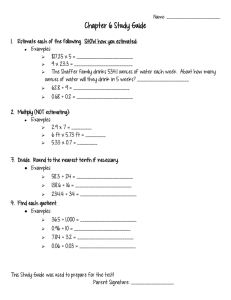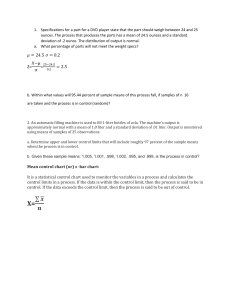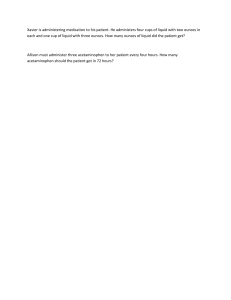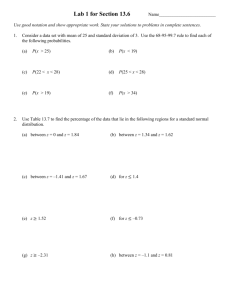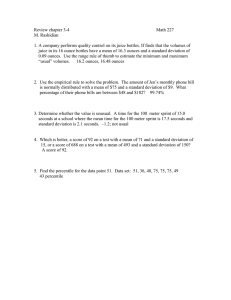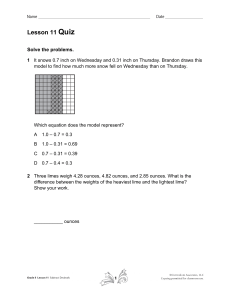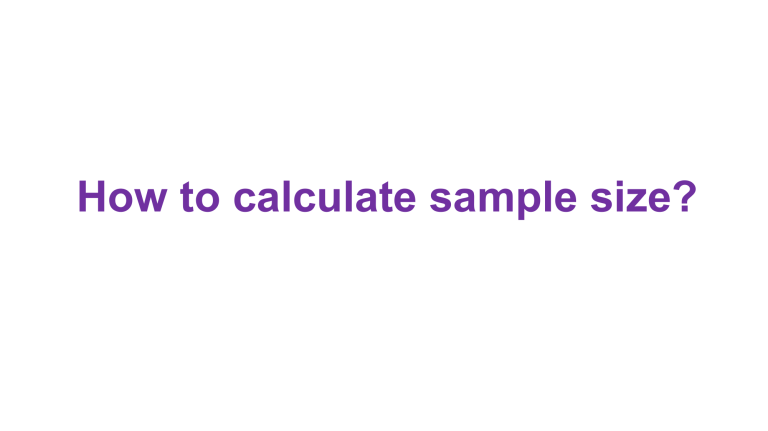
How to calculate sample size? How to calculate sample Size? Sample design addresses two basic issues; how elements of the population will be selected & how many elements will be selected. • Sampling techniques - Probability and non – probability sampling • Estimating sample size - How large sample is required? How to calculate sample Size? • Inadequate, or excessive sample sizes influence the quality and accuracy of research. • Sample Size refers to the number of items to be selected from the universe to constitute a sample. • If the sample size is too small, it may not serve to achieve the objectives How to calculate sample Size? Too large sample size might cause huge cost • How large or small should be the sample size? As a general rule, the sample must be of an optimum size Optimum means the ideal sample provides the most precision for the least cost Criteria for sample size • Population size: Population size is the total number of people in the group you are interested in, or in this case, trying to reach with your survey. • For example, if you were taking a random sample of students in a high school, your population would be the total number of students attending that school. • Similarly, if you wanted a survey on the United States, the size of the population would be the total number of people in the USA and if you are surveying your company, the size of the population is the total number of employees. Criteria for sample size • Margin of error: Margin of error, also called the confidence interval, is a statistical measurement of difference between survey results and the population value, expressed as a percentage. • Within the survey ecosystem, the margin of error measures the difference between your survey results and how accurately they reflect the views of the overall population. • The smaller the margin of error, the closer you are to having the exact answer at a given confidence level. Criteria for sample size • Confidence level (not to be confused with confidence interval) is a measure of how certain you are that your sample accurately reflects the population, within its margin of error. • Using the high school example, let’s say you conducted a survey among a sample of students to see if breakfast is popular amongst high scholars. Criteria for sample size • The survey results conclude that 60% of your respondents like to eat breakfast every morning. With a 4% margin of error rate and a 95% confidence level, it is safe to say that if the survey was repeated numerous times, the answers would reflect the same results 95% of the time(i.e. a 95% confidence level means that you can be 95% certain the results lie between x and y numbers). • Common standards used by researchers are 90%, 95%, and 99%. Criteria for sample size • Degree of variability refers to the distribution of attributes in the population. • The more heterogeneous a population, the larger the sample size required • The less variable (more homogeneous) a population, the smaller the sample size. Estimating Sample Size Sample size for infinite population • In a population with standard deviation σ, with an error e, & a confidence corresponding to z, sample size, n, equals: where; n = size of sample e = acceptable error (the precision) σ = standard deviation of population z = number relating to the degree of confidence you wish to have in the result. Sample Size for finite population • For finite population, sample size is given by: where N = size of population n = size of sample e = acceptable error (the precision) σp = standard deviation of population z = number relating to the degree of confidence you wish to have in the result. Example: • Determine the sample size for estimating the true weight of the cereal containers for the universe with N = 5000 on the basis of the following information: • The variance of weight is 4 ounces on the basis of past records. • Estimate should be within 0.8 ounces of the true average weight with 99% probability. will there be a change in the size of the sample if we assume infinite population in the given case? Solution N = 5000; σp = 2 ounces (since the variance of weight = 4 ounces); e = 0.8 ounces (since the estimate should be within 0.8 ounces of the true average weight); z = 2.57 (as per the table of area under normal curve for at 99% confidence level ). Solution N = 5000; σp = 2 ounces (since the variance of weight = 4 ounces); e = 0.8 ounces (since the estimate should be within 0.8 ounces of the true average weight); z = 2.57 (as per the table of area under normal curve for at 99% confidence level ). (ii) infinite population (2.57)2 (2) 2 26.4196 n= = = 41.28 41 2 (0.8) 0.64 Thus in the given case the sample size remains the same even if we assume infinite population Example: The government would like to estimate the mean family size for all families in a particular state at a 99% confidence level. It is known that the standard deviation for all sizes of all families in that state is 0.7.How large a sample should the government select if it wants its estimate to be within 1% of the population mean? Solution: Dr. Monika Saini, Department of Mathematics & Statistics, Manipal University Jaipur Example: The government would like to estimate the mean family size for all families in a particular state at a 99% confidence level. It is known that the standard deviation for all sizes of all families in that state is 0.7.How large a sample should the government select if it wants its estimate to be within 1% of the population mean? Solution: e = 0.01, Z = 2.57, = 0.7 2 2 (2.57) (0.7) n= = 32, 616 2 (0.01) Dr. Monika Saini, Department of Mathematics & Statistics, Manipal University Jaipur Solvin’s Formula Solvin’s formula is used when nothing about the behavior of the population is known at all. Where n is the sample size, N is the population size, and e is the level of precision: Example: Suppose our evaluation of farmers' adoption of the new practice only affected 2,000 farmers allowing for a 5% margin or error. . The sample size: Dr. Monika Saini, Department of Mathematics & Statistics, Manipal University Jaipur Example: Suppose our evaluation of farmers' adoption of the new practice only affected 2,000 farmers allowing for a 5% margin or error. . The sample size: Dr. Monika Saini, Department of Mathematics & Statistics, Manipal University Jaipur Example: Calculate the survey size for a population of 240, allowing for a 4% margin or error. Hint: N=240, e=0.04 Answer: n=173
